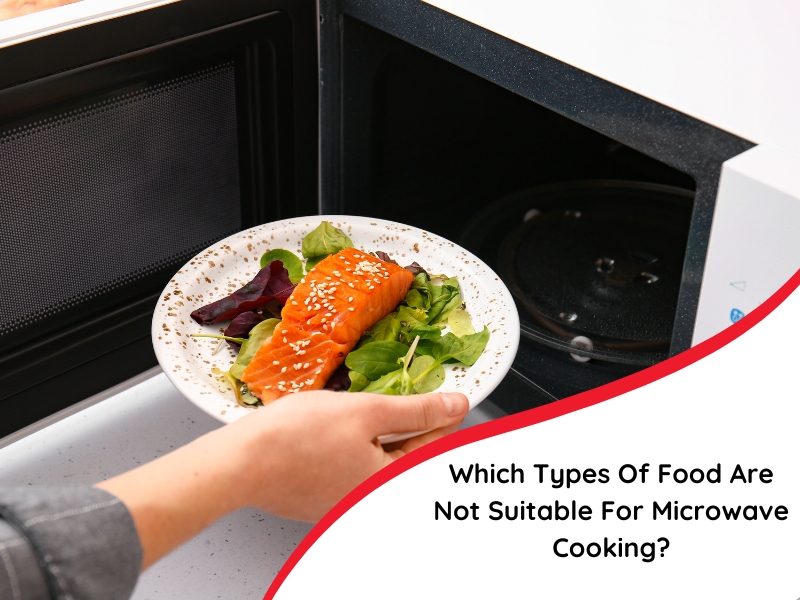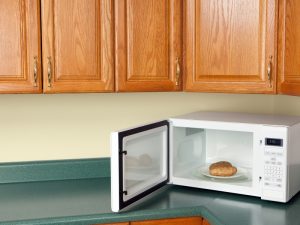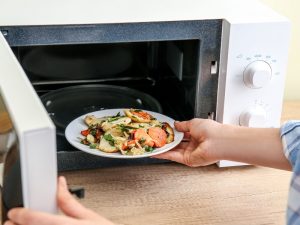Microwave cooking is a convenient way to prepare meals quickly, but not all foods suit this method. While microwaves can heat food efficiently, they work by using radiation to vibrate water molecules, which generates heat. This process can affect certain types of food’s texture, taste, and safety. In this article, we’ll explore which foods are not ideal for microwave cooking, why they should be avoided, and how you can ensure safe and effective use of your microwave.
What are the risks of microwave cooking for certain foods?
Before diving into specific foods, it’s essential to understand the general risks involved in microwave cooking. Some foods don’t react well to the microwave, and microwaving them could result in poor texture, flavour, or even safety concerns. Here are a few risks you should keep in mind when using the microwave:
- Uneven heating: Microwaves heat food unevenly, which can leave cold spots, especially in thick or dense foods.
- Texture and taste changes: Some foods lose their texture or taste when microwaved, making them less enjoyable.
- Potential for explosions: Some foods can explode if not appropriately prepared for microwave cooking, creating a mess and posing a safety risk.
- Loss of nutrients: Certain foods lose more nutrients in the microwave than when cooked by other methods, such as steaming or boiling.
Considering these risks, let’s now look at the foods most likely to cause issues in the microwave.
Why are raw eggs unsafe for microwave cooking?
While it might seem convenient, raw eggs are not ideal for microwave cooking. The microwave heats food quickly, which can cause eggs to cook too fast and unevenly. Here are a few reasons why:
- Eggshell explosions: When cooking eggs with their shells, the rapid heat can cause them to explode, creating a mess in the microwave and potential safety risks.
- Uneven cooking: Raw eggs often cook unevenly in the microwave, leading to runny or overcooked spots.
- Texture issues: Microwaved eggs can become rubbery and unevenly cooked, especially if your microwave isn’t heating correctly, which is unappetising for many people.
If you’re in a hurry and need to cook eggs, consider boiling or scrambling them on the stove for better results.
What foods are likely to explode in the microwave?
Certain foods are more likely to explode in the microwave because they retain moisture and heat up. Here are a few of them:
- Potatoes: Whole potatoes can explode due to steam build-up inside the skin. Always pierce the skin with a fork before microwaving.
- Hot dogs: Their casing can trap steam, causing them to explode unless they’re punctured before microwaving.
- Tomatoes: Microwaving whole tomatoes can cause them to burst from the pressure of their skin.
- Whole fruits: Fruits like grapes and apples can explode because their skin prevents steam from escaping.
To avoid explosions, always pierce or slice these foods before microwaving them.
Which dairy products should you avoid when cooking in a microwave?
Dairy products can be tricky when it comes to microwave cooking. Some types of dairy react poorly to the microwave’s direct heat, leading to separation, curdling, or an unpleasant texture. The following dairy products are best avoided in the microwave:
- Milk: Heating milk too quickly in the microwave can cause it to boil or form curdles. To prevent this, microwave in short intervals and stir frequently.
- Cheese: Hard cheeses can become rubbery when microwaved, while softer cheeses like cream cheese can separate into curds and whey. Be cautious when melting cheese, and avoid overheating.
- Yogurt: Like milk, yogurt can curdle when exposed to high microwave heat. It’s best to microwave yogurt in short bursts, stirring between intervals.
If you need to microwave dairy products, use low settings and stir frequently to avoid these issues.
What types of meat are not ideal for microwave cooking?
Microwaving meat is often not ideal due to how heat is distributed in the microwave. When microwaving meat, it can become dry, rubbery, or overcooked on the outside while still raw on the inside. The following meats should be avoided or prepared carefully in the microwave:
- Steak and other red meats: Microwaving steak can produce a tough, rubbery texture, as the microwave doesn’t allow for even cooking. Steaks are better off being cooked on the grill or stovetop.
- Chicken: While small portions of chicken can be microwaved, more significant cuts may not cook evenly. The outside can become overcooked while the inside remains raw, posing a food safety risk like salmonella infections.
- Pork: Like red meats, pork can become dry and tough in the microwave. It’s best cooked using other methods that allow for more even heating.
For the best results, use traditional methods like grilling, roasting, or pan-frying for meats. If you do need to use the microwave, ensure that the meat is cut into smaller, uniform pieces to allow for more even cooking.
Is microwave cooking suitable for foods with high water content?
Foods with a high water content, such as certain fruits and vegetables, can be problematic when microwaved. Here’s why:
- Overheating: Due to their high water content, foods like watermelon, cucumbers, and leafy greens can become overly soggy or mushy when microwaved. The microwave causes water to evaporate rapidly, affecting the food’s texture.
- Uneven cooking: High-water-content foods tend to heat unevenly in the microwave, with some parts getting too hot while others remain cold.
For best results, try steaming or roasting these foods instead. If you microwave them, cut them into smaller pieces and use a microwave-safe cover to help distribute the heat evenly.
Why is it not recommended to microwave processed foods?
Processed foods, especially those containing preservatives or artificial additives, may not react well to microwave cooking. Here’s why:
- Chemical reactions: Some additives in processed foods may react negatively to microwave heat, altering the taste, texture, or nutritional value of the food.
- Texture issues: Many processed foods, like ready-to-eat meals or microwaveable snacks, are designed to be heated in an oven or stovetop, not a microwave. Microwaving them can result in sogginess or uneven cooking.
Processed foods are often best cooked according to the package instructions, which usually suggest baking or stovetop heating methods.
How can you ensure safe microwave cooking for all foods?
To ensure safe and effective microwave cooking, consider these tips:
- Use microwave-safe containers: Always use containers marked as microwave-safe to avoid harmful chemicals leaching into your food.
- Stir and rotate: Stirring and rotating your food during cooking ensures even heating and prevents cold spots.
- Cover your food: Use a microwave-safe cover to trap moisture and heat, allowing food to cook evenly and retain flavour.
- Check for doneness: Always check the temperature of food to ensure it has reached a safe internal temperature, particularly for meats.
Following these tips will help ensure that your microwave cooking results are safe and tasty.
Microwaving smartly
While the microwave is an excellent tool for many foods, it’s essential to understand which foods are better suited to other cooking methods. By being mindful of the risks and limitations of microwave cooking, you can ensure better texture, taste, and safety in your meals.
At Microwave Factory, we offer expertly refurbished and factory-series microwaves that combine quality and affordability. Our commitment to restoring appliances to like-new condition ensures you get a reliable product at an unbeatable price. With our Best Price Guarantee and a 3-month purchase warranty, you can shop confidently, knowing your investment is protected. Trust Microwave Factory for top-tier customer satisfaction and long-lasting performance. Contact Microwave Factory today to find the perfect microwave for your needs!
Frequently Asked Questions
- Can I microwave all types of leftovers?
Not all leftovers reheat well in the microwave. Consider the original cooking method and the food’s texture.
- What’s the best way to reheat bread in the microwave?
Microwaving bread can make it challenging. Try wrapping it in a damp paper towel and heating it in short bursts.
- Are there specific containers I should avoid in the microwave?
Yes, avoid metal, foil, and some non microwave-safe plastics. - Where can I find a reliable and affordable microwave?
Microwave Factory offers top-quality refurbished microwaves with warranties.
- How do I prevent splattering when microwaving sauces or liquids?
Use a microwave-safe cover and stir occasionally.
- Can I microwave frozen food directly?
Some frozen foods have microwave instructions. Otherwise, defrosting is recommended for even cooking.
- What does “microwave-safe” mean?
It indicates the material is designed to withstand microwave heat without leaching chemicals.
- How can I tell if my food is cooked thoroughly in the microwave?
Check the internal temperature with a food thermometer, especially for meat.
- Is it safe to reheat food multiple times in the microwave?
Reheating multiple times can affect food quality and potential safety. It’s generally best to reheat only what you’ll consume then.
- How can I prevent uneven heating in the microwave?
Stir and rotate your food regularly to ensure even heating.



